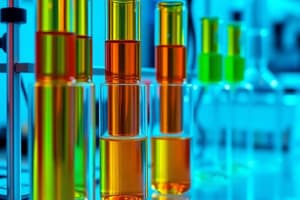Podcast
Questions and Answers
What is HPLC?
What is HPLC?
- High Pressure Liquid Chromatography
- High Precision Liquid Chromatography
- High Performance Liquid Chromatography (correct)
- High Purity Liquid Chromatography
What is the main difference between liquid chromatography and HPLC?
What is the main difference between liquid chromatography and HPLC?
- The size of the column
- The use of pumps to increase speed and efficiency (correct)
- The type of compound being separated
- The type of solvent used
What is the purpose of the pump in an HPLC system?
What is the purpose of the pump in an HPLC system?
- To detect the compounds eluting from the column
- To measure the pressure of the system
- To separate the compounds in the sample
- To take the solvent from the solvent container and move it through the column (correct)
What is the mobile phase in liquid chromatography?
What is the mobile phase in liquid chromatography?
What is the stationary phase in liquid chromatography?
What is the stationary phase in liquid chromatography?
Which technique is used to analyze copy number variations in DNA samples without the need for culturing cells?
Which technique is used to analyze copy number variations in DNA samples without the need for culturing cells?
What is the primary aim of comparative genomic hybridization (CGH)?
What is the primary aim of comparative genomic hybridization (CGH)?
What is the improved resolution of comparative genomic hybridization (CGH) compared to giemsa banding and fluorescence in situ hybridization (FISH)?
What is the improved resolution of comparative genomic hybridization (CGH) compared to giemsa banding and fluorescence in situ hybridization (FISH)?
What type of differences can be detected using comparative genomic hybridization (CGH)?
What type of differences can be detected using comparative genomic hybridization (CGH)?
Which technique was comparative genomic hybridization (CGH) originally developed for?
Which technique was comparative genomic hybridization (CGH) originally developed for?
Flashcards are hidden until you start studying
Study Notes
Chromatography
- HPLC (High-Performance Liquid Chromatography) is a type of liquid chromatography that uses high pressure to achieve better separation and faster analysis.
- The main difference between liquid chromatography and HPLC is the use of high pressure in HPLC, which allows for better separation and faster analysis.
HPLC System Components
- The pump in an HPLC system is used to force the mobile phase through the column at high pressure.
Liquid Chromatography Phases
- The mobile phase in liquid chromatography is the solvent that carries the sample through the column.
- The stationary phase in liquid chromatography is the solid material in the column that separates the sample components based on their interactions.
Comparative Genomic Hybridization (CGH)
- CGH is a technique used to analyze copy number variations in DNA samples without the need for culturing cells.
- The primary aim of CGH is to detect regional changes in DNA copy number between a test and a reference genome.
- CGH has an improved resolution of 5-20 Mb compared to giemsa banding (5-10 Mb) and fluorescence in situ hybridization (FISH) (10-20 Mb).
- CGH can detect gains and losses of DNA segments, including amplifications and deletions.
- CGH was originally developed for cancer research to detect DNA copy number changes in tumors.
Studying That Suits You
Use AI to generate personalized quizzes and flashcards to suit your learning preferences.




